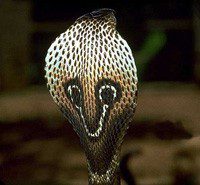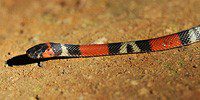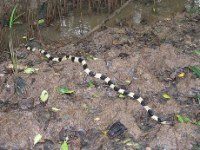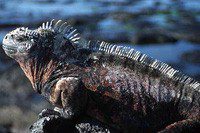
Marine iguana
Charles Darwin called this lizard an ugly and stupid animal, although he collected perhaps the most information about it. We are talking about the marine iguana (lat. Amblyrhynchus cristatus) – the only representative of the iguana family, whose life is closely connected with the aquatic environment. In essence, marine iguanas are unique – they are the only lizards that are able to spend most of their lives in the water, are listed in the IUCN Red List, live exclusively on the Galapagos Islands and know how to sneeze. The appearance of marine iguanas is indeed bizarre. These are massive lizards, with powerful clawed feet and a noticeable horny ridge along the ridge. If you look at a marine iguana up close, you get the feeling that it is all covered with armor, and a shell with spikes is put on its head – this impression is produced by rough scaly skin with larger cone-shaped protrusions on the forehead. Outwardly, these lizards are a bit like prehistoric animals – dinosaurs. And although marine iguanas are rather slow creatures on land, their size – up to 140 cm in length – and their rather intimidating appearance scare away predators. And this species is perhaps the least studied among other iguanas. In addition to Darwin, the zoologist Bell described it in the 19th century, so our scientific contemporaries still have the opportunity to “fill in the gaps” in knowledge about the existence of marine iguanas.
Contents
Classification
Kingdom: Animals
Type: Chord
Class: Sauropsids
Order: Scaly
Family: Iguana
Genus: Marine iguanas
Species: Marine iguana Amblyrhynchus cristatus
Appearance
 Peaceful dragon – this is how Bishop Thomas de Berlanga, who met him in the Galapagos, called this reptile. And indeed, there is something in the appearance of sea lizards from fabulous, mythical creatures. At one time, it was the amazing appearance that saved marine iguanas from human hunting, unlike, for example, the Galapagos tortoises. The marine iguana is a lizard with a massive body, but a short head covered with horny protrusions. Along the entire ridge, from the head of the lizard to the tail, there is a crest of triangular, claw-shaped and rather high scales. And the tail of the marine iguana itself is thick and long, taking up more than half the length of its entire body. It helps the lizard to swim dexterously. And, like a sea creature, the iguana’s paws are equipped with swimming membranes and also have sharp claws. But in the water, the marine iguana does not use them, but stretches the limbs back and presses them firmly to the sides. But they help to climb the frozen coastal lava perfectly.
Peaceful dragon – this is how Bishop Thomas de Berlanga, who met him in the Galapagos, called this reptile. And indeed, there is something in the appearance of sea lizards from fabulous, mythical creatures. At one time, it was the amazing appearance that saved marine iguanas from human hunting, unlike, for example, the Galapagos tortoises. The marine iguana is a lizard with a massive body, but a short head covered with horny protrusions. Along the entire ridge, from the head of the lizard to the tail, there is a crest of triangular, claw-shaped and rather high scales. And the tail of the marine iguana itself is thick and long, taking up more than half the length of its entire body. It helps the lizard to swim dexterously. And, like a sea creature, the iguana’s paws are equipped with swimming membranes and also have sharp claws. But in the water, the marine iguana does not use them, but stretches the limbs back and presses them firmly to the sides. But they help to climb the frozen coastal lava perfectly.
The color of the marine iguana is dark gray, sometimes with greenish or reddish hues in some parts of the body and blurry spots. It has already been mentioned that the lizard has the unique ability to sneeze. This helps her to remove from the body the salt that accumulates when diving. When a lizard sneezes, droplets of liquid are released from its nose, washing the body and removing excess salt. As a cold-blooded animal, the marine iguana needs to take in as much external heat as possible to thrive, which is why it often basks on rocks after leaving the sea. The weight of the reptile is up to 12 kg, and most of the mass falls on a huge paddle-shaped tail. The scales of the marine iguana are ribbed, small, but large quadrangular scales are located on the tail in the form of a keel. Protrusions of various shapes also stand out on the head of the lizard, and the head crest is especially noticeably developed.
Distribution and habitation
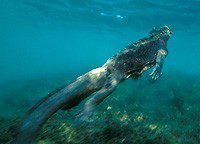 The marine iguana is endemic to the Galapagos Islands. Perhaps it was their remoteness and sparse population that contributed to the insufficient study of this creature. You can meet a lizard on any of the islands of the archipelago, most often on the coast with many rocks, near salt marshes or in coastal bushes. The shores of the Galapagos consist mainly of a cooled lava mass, and it is on it that iguanas prefer to live, moreover, mainly on the shallows, and not near great depths. Sea lions often live next to lizards, also preferring the coast. But if these seals climb the shore from the gentle side, then the iguanas easily climb the vertical rocky sides of the coast with the help of strong claws.
The marine iguana is endemic to the Galapagos Islands. Perhaps it was their remoteness and sparse population that contributed to the insufficient study of this creature. You can meet a lizard on any of the islands of the archipelago, most often on the coast with many rocks, near salt marshes or in coastal bushes. The shores of the Galapagos consist mainly of a cooled lava mass, and it is on it that iguanas prefer to live, moreover, mainly on the shallows, and not near great depths. Sea lions often live next to lizards, also preferring the coast. But if these seals climb the shore from the gentle side, then the iguanas easily climb the vertical rocky sides of the coast with the help of strong claws.
Behavior and lifestyle
This lizard really spends a lot of time in the water. Moreover, the young never swim far from the shore. And among adult marine iguanas, males demonstrate the most fearless behavior, capable of swimming long distances, but also no more than a few hundred meters. Under water, lizards spend about an hour holding their breath for this period. But since there are a lot of cold underwater currents around the Galapagos coast, after swimming, marine iguanas have to bask. Under water, their body temperature drops by 30 degrees, and lizards do not have subcutaneous fat, so they often take sunbaths on the surface, thereby normalizing heat transfer. In the water, marine iguanas are exceptionally agile and fast. When swimming, they seem to wriggle their whole body and tail. The endurance of the lizard is also facilitated by the ability to slow down the heart rate under water and let the outflow of blood only to the vital organs. And when they come ashore, marine iguanas cling tightly to the stones with powerful claws, better absorbing the heat of the sun due to their almost black color. But lizards never move more than a few meters from the water.
Darwin set up an experiment by throwing a marine iguana into a deep place, but every time it returned to the ground. The scientist suggested that this is due to the fear of sea sharks, perhaps the only threats to the lizard in the water. On land, she is safer. However, another researcher, Blomberg, nevertheless established one land enemy for marine iguanas – a feral dog. After all, in fact, this lizard is not particularly able to defend itself, having sharp teeth, but not using them to defend its life, but using it only for food in the water. The greatest depth to which the marine iguana is able to dive is 12 meters, but more often lizards dive to 1-5 meters, holding on to the bottom with the help of claws. On the shore, marine iguanas keep in whole flocks in groups of 5-5 females with young animals close enough to each other. If you disturb the lizard on the shore, then it will not be going to hide in the water, but will only reluctantly crawl to the side. Marine iguanas show a surprisingly indifferent attitude towards both the nearby person and other animals.
Food
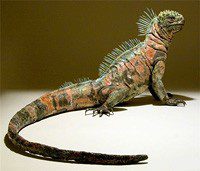 Despite the rather intimidating appearance, marine iguanas have nothing to do with predators, being herbivorous reptiles. Their main food is seaweed, which lizards bite off stones with long, three-pointed teeth. And only sometimes lizards allow themselves to eat a red crab or other small sea creature, and even then this is more typical of young marine iguanas. Along with seaweed, a lot of salt also enters the body of lizards, so after eating they often use their salt-removing mechanism – they sneeze on the shore. For food, marine iguanas are able to dive deep enough. However, the field of information about the nutrition of marine lizards also has many gaps. In particular, one of the inhabitants of the Galapagos easily taught them to feed on human food – meat, pasta, bread and even oatmeal.
Despite the rather intimidating appearance, marine iguanas have nothing to do with predators, being herbivorous reptiles. Their main food is seaweed, which lizards bite off stones with long, three-pointed teeth. And only sometimes lizards allow themselves to eat a red crab or other small sea creature, and even then this is more typical of young marine iguanas. Along with seaweed, a lot of salt also enters the body of lizards, so after eating they often use their salt-removing mechanism – they sneeze on the shore. For food, marine iguanas are able to dive deep enough. However, the field of information about the nutrition of marine lizards also has many gaps. In particular, one of the inhabitants of the Galapagos easily taught them to feed on human food – meat, pasta, bread and even oatmeal.
Reproduction
 Reproduction of marine iguanas is perhaps the most mysterious part of their lives. For example, Darwin was never able to collect information about him. But some facts in modern zoology are still known. In particular, that marine iguanas are characterized by large family groups, whose representatives try not to enter foreign territory, being actively driven out by its “owners”. This is another reason why the marine iguana thrown into the sea by Darwin kept returning to its place. The head of each such family is, of course, a large and strong male. Several females and grown offspring live next to him. Sometimes young males try to challenge the right to own the “harem” from the old ones by arranging fights. Watching the fights of marine iguanas is interesting. They, like two sheep, butt heads, arching their backs and trying to push the opponent out of their area. In this way, lizards resemble other marine animals, such as elephants or walruses. But such encounters are far from harmless. Scientists have observed how, sneezing after a fight, one of the males, instead of droplets of water, splashes blood from the nostrils.
Reproduction of marine iguanas is perhaps the most mysterious part of their lives. For example, Darwin was never able to collect information about him. But some facts in modern zoology are still known. In particular, that marine iguanas are characterized by large family groups, whose representatives try not to enter foreign territory, being actively driven out by its “owners”. This is another reason why the marine iguana thrown into the sea by Darwin kept returning to its place. The head of each such family is, of course, a large and strong male. Several females and grown offspring live next to him. Sometimes young males try to challenge the right to own the “harem” from the old ones by arranging fights. Watching the fights of marine iguanas is interesting. They, like two sheep, butt heads, arching their backs and trying to push the opponent out of their area. In this way, lizards resemble other marine animals, such as elephants or walruses. But such encounters are far from harmless. Scientists have observed how, sneezing after a fight, one of the males, instead of droplets of water, splashes blood from the nostrils.
In the mating season, the male marine iguana “dresses” a special outfit, consisting of red spots on the skin. And after mating, the female arranges masonry. Marine iguanas are not accidentally considered a protected species, their fecundity is low. Clutches occur no more than once a year, and consist of a maximum of three, or even one egg. Like other lizards, female marine iguanas try to bury their eggs in sandy soil, but there are few such areas on the lava shores, so often a female who has found a suitable place has to actively chase away her rivals, including her “harem” neighbors. And the very arrangement of the place for masonry in female marine iguanas is active. They scatter sand in such a way that they can fall asleep a neighbor who is nearby or even accidentally destroy someone else’s masonry. In general, during the breeding season, female marine iguanas are particularly aggressive.
Young individuals hatch from eggs in about 3-4 months and can stay close to their parents, expanding and replenishing their family group until they reach sexual maturity.
Additionally
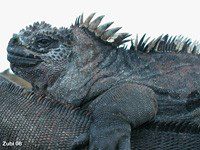 Did you know that marine iguanas have their own language, which animal language experts consider to be quite capacious and rich? These are not sounds, but the “alphabet” of movements. For example, male lizards challenge each other to a mating match with special nods. Other nods indicate other calls and messages, it all depends on their frequency and amplitude. One marine iguana may signal to another that it is “giving up” or, conversely, is ready to assert the right to mate until victory. By the way, different species of iguanas living in the same territory have different “dialects” so as not to confuse the signs sent by other species.
Did you know that marine iguanas have their own language, which animal language experts consider to be quite capacious and rich? These are not sounds, but the “alphabet” of movements. For example, male lizards challenge each other to a mating match with special nods. Other nods indicate other calls and messages, it all depends on their frequency and amplitude. One marine iguana may signal to another that it is “giving up” or, conversely, is ready to assert the right to mate until victory. By the way, different species of iguanas living in the same territory have different “dialects” so as not to confuse the signs sent by other species.
Another interesting feature of lizards is their behavior in so-called families, which is reflected in the proverb “the family has its black sheep”. This means that in each family group of marine iguanas, a “scapegoat” may appear – a lizard that the entire group will methodically oppress, expelling to the worst places or even depriving them of food. There are cases when such an exile died from exhaustion. True, this self-affirmation of marine iguanas has been recorded only when they exist in captivity, since the territory of their habitat in artificial conditions is usually limited.
And marine iguanas on land and water have little helpers – crabs and abudelduf fish. These are cleaners that feed on parasites that give sea lizards a lot of problems.
Sources of
http://ru.wikipedia.org/
http://www.seapeace.ru/
http://www.ekzotik-animal.com/
http://travel.vivaservicio.com/
http://www.floranimal.ru/
http://aquaria2.ru



